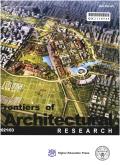“设计本质”:德绍包豪斯学校建筑的色彩诠释及其概念起源
IF 3.6
1区 艺术学
0 ARCHITECTURE
引用次数: 0
摘要
在现代主义建筑中,色彩是塑造空间体验的重要工具。然而,由于历史原因,早期现代主义建筑的色彩设计并没有得到充分的探索。本文关注的是标志性的现代主义作品——德绍的包豪斯学校建筑。通过历史调查和理论研究,从色彩理论发展、建筑色彩特征、视觉感知与色彩互动等方面阐述了色彩认知的演变。在此基础上,探讨包豪斯和格罗皮乌斯的色彩理论渊源,剖析德绍包豪斯学校建筑色彩设计背后的概念框架和方法。此外,本文还从体验的角度分析了建筑色彩的空间特征。本文认为格罗皮乌斯通过色彩设计传达了他的“自然透视”理念,强调自然内在逻辑的永恒价值。包豪斯重新定义了色彩在建筑表现中的作用,以自然规律为基础,推导出一种与感知相关的科学设计方法,推动了色彩设计从主观到客观的转变,为建筑色彩注入了更深层次的内涵。本文章由计算机程序翻译,如有差异,请以英文原文为准。
“Design nature”: A color interpretation of Bauhaus school building in Dessau and its conceptual origins
In modernist architecture, color serves as a crucial tool in shaping spatial experiences. However, due to historical reasons, the color design of early modernist architecture has not been fully explored. The paper focuses on the iconic modernist work, the Bauhaus school building in Dessau. Through historical investigation and theoretical research, it elucidates the evolution of color cognition from the perspectives of color theory development, architectural color characteristics, and the interaction between visual perception and color. On this basis, it explores the color theory origins of the Bauhaus and Gropius, dissecting the conceptual framework and methods behind the color design of the Bauhaus school building in Dessau. Additionally, this article analyzes the spatial characteristics of architectural color from an experiential standpoint. The paper argues that Gropius conveyed his concept of “natural perspective” through color design, emphasizing the eternal value of natural internal logic. The Bauhaus redefined the role of color in architectural expression, based on natural laws, and deduced a scientifically designed method related to perception, promoting a shift in color design from subjective to objective and injecting deeper connotations into architectural color.
求助全文
通过发布文献求助,成功后即可免费获取论文全文。
去求助
来源期刊

Frontiers of Architectural Research
ARCHITECTURE-
CiteScore
6.20
自引率
2.90%
发文量
430
审稿时长
30 weeks
期刊介绍:
Frontiers of Architectural Research is an international journal that publishes original research papers, review articles, and case studies to promote rapid communication and exchange among scholars, architects, and engineers. This journal introduces and reviews significant and pioneering achievements in the field of architecture research. Subject areas include the primary branches of architecture, such as architectural design and theory, architectural science and technology, urban planning, landscaping architecture, existing building renovation, and architectural heritage conservation. The journal encourages studies based on a rigorous scientific approach and state-of-the-art technology. All published papers reflect original research works and basic theories, models, computing, and design in architecture. High-quality papers addressing the social aspects of architecture are also welcome. This journal is strictly peer-reviewed and accepts only original manuscripts submitted in English.
 求助内容:
求助内容: 应助结果提醒方式:
应助结果提醒方式:


